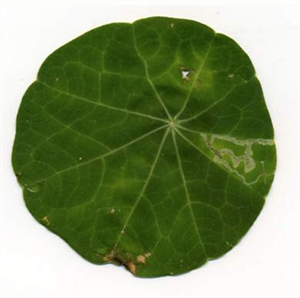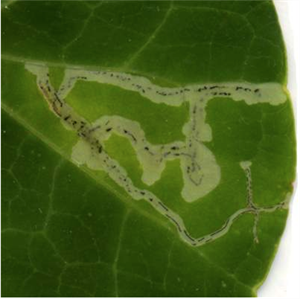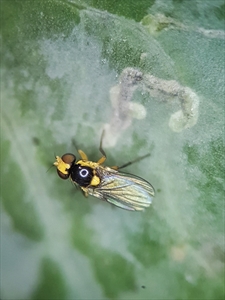Cabbage leafminer, Serpentine leafminer (the same common name is given to other leafminers (see Fact Sheets nos. 110, 259, 262 & 377)
Pacific Pests, Pathogens, Weeds & Pesticides - Online edition
Pacific Pests, Pathogens, Weeds & Pesticides
Cabbage leafminer (377)
Liriomyza brassicae. See other fact sheets for accounts on separate species (Fact Sheet nos. 259 & 262) and, for a general account, (see Fact Sheet no. 110).
South and Southeast Asia, Africa, North and South America, the Caribbean, Europe, Oceania. It has been recorded from Australia, Federated States of Micronesia, Fiji, Guam, New Zealand, Northern Mariana Islands, Papua New Guinea.
Cabbage family (Brassicaceae), e.g., head cabbage, Chinese cabbage, radish, and the pea, bean or legume family (Fabaceae), e.g, pea. The ornamental, garden nasturtium (Tropaeolum majus) and weeds are also hosts.
The larvae of the fly does the damage by making irregular, pale-coloured mines in the leaves (Photos 1&2). There may be many mines per leaf, sometimes, covering the entire leaf blade.
Eggs are minute and laid singly under the epidermis on both sides of the leaves. Many eggs are laid on each leaf. On pea, the mines start on the lower leaves and increases with the age of the crop until all are affected.
The fully-grown larva (maggot) is 2.5 mm long, and yellow-green. It makes a winding, snake-like mine that gradually widens, and which is more clearly visible on the top surface of the leaf. A dark green line of faeces is present usually in the middle of the mine. The maggot changes its skin three times before it is mature.
The mature larva cuts its way out of the mine and falls to the soil, becoming an oval, shiny, brown, puparium. The pupa is inside, enclosed by the hardened last skin of the maggot.
The adult is 1.5-1.8 mm long (about 2.5 mm including the wings). The head between the eyes, the antennae, the top of the 'scutellum', and the last part of the thorax are all yellow (Photo 3). The rest of the thorax, and the abdomen, are black on top (Photo 4). The fly is similar to Liriomyza sativae (see Fact Sheet no. 262). The life cycle is 3-4 weeks at 30°C. Females puncture the surface of the leaves with their ovipositors, the tubes used for egg laying, and either lay an egg at the wounded site or feed on the juices released. Males cannot puncture leaves, and so they, as well as the females, take nectar from flowers.
Spread is by flying and by the movement of plants, soil or packaging.
The leafminer is very common on Chinese cabbage and pea in Fiji, but the economic effect on the crop is unknown. In Hawaii, it is considered a serious pest on broccoli, cabbage, cauliflower, Chinese broccoli, flowering white cabbage and other cruciferous crops. Elsewhere, the impact is possibly greater, although not well detailed. On ornamentals, the mines may reduce market value. On cabbages, the damage is largely on the outer leaves, and these are discarded before sale, so loss is low. On young plants and seedlings, there is the possibility that they will be severely weakened or even killed and, hence the loss may be greater than plants growing in the field.
Look for the yellow and black flies moving rapidly over the leaf surface. Look at the head, antennae and the first segment of the legs, which are bright yellow. The several species of Liriomyza are similar and require taxonomic expertise to tell them apart.
BIOSECURITY
Although widely distributed, there are many countries still vulnerable to introduction of Liriomyza brassicae. Therefore, it is necessary to prevent this leafminer from extending its range. Biosecurity authorities need to be alert to the fact that movement of this pest across national borders is associated with the trade in nursery plants, cut flowers and vegetables. Liriomyza sativae is listed as an A2 quarantine pest by EPPO, the European Plant Protection Organisation. A2 pests are locally present in the EPPO region.
NATURAL ENEMIES
There are many wasp parasitoids that are natural enemies of Liriomyza brassicae. In California, USA, rates of parasitisation are very high. Many parasitoids that attack eggs, larvae and pupae, are known from Australia, New Zealand and Hawaii, and are also present elsewhere, i.e., species of Opius, Hemiptarsenus, Closterocerus, Diglyphus, Cothonaspis, Chrysachares, and Halticoptera. Records of parasitoids from the Pacific are wanting.
CULTURAL CONTROL
Compared to other species of leafminer, e.g., Liriomyza sativa and Liriomyza trifolii, damage done by the cabbage leafminer, Liriomyza brassicae, is generally much less. This is the case in Fiji, although the economic impact is unknown. Therefore, it is best to test cultural control measures first before resorting to insecticides. If insecticides are used, avoid those with broad-spectrum activity in order to preserve parasiotoids and avoid insecticide resistance developing in the leafminer population.
Before planting:
- Maintain good weed control in and around nursery areas and in the field.
- Plough the land before planting to expose the pupae in the soil.
- Carefully check each plant for signs of mines before planting in the field.
- Avoid planting a new crop susceptible to leafminers immediately after the harvest of an older one; leave 1-2 weeks for pupae in the soil to hatch.
During growth:
- Handpick leaves with mines if numbers are low, or destroy the mines in place.
- Keep weeds to a minimum in and around field crops.
After harvest:
- Collect and burn or bury trash after harvest.
- In high-value crops cover the soil with mulch to prevent the adults emerging from the soil.
CHEMICAL CONTROL
If insecticides are needed, avoid using broad spectrum types, for instance synthetic pyrethroids, carbamates or organophosphates. Not only will they destroy natural enemies, but are likely result in resistant leafminer populations. Use the following:
- Botanicals, e.g., neem; it is said to reduce the egg-laying period of leafminers and affect the development of the maggots.
- Microbials, e.g., abamectin and spinosad, both derived from bacteria. Abamectin is considered the most effective and least harmful to natural enemies.
- Growth regulators, e.g., cyromazine.
____________________
When using a pesticide, always wear protective clothing and follow the instructions on the product label, such as dosage, timing of application, and pre-harvest interval. Recommendations will vary with the crop and system of cultivation. Expert advice on the most appropriate pesticides to use should always be sought from local agricultural authorities.
AUTHOR Grahame Jackson
Information from CABI (2018) Liriomyza brassicae (serpentine leafminer). Crop Protection Compendium. (https://www.cabi.org/cpc/datasheet/30949); and from Martin NA (2017) Cabbage leafminer - Liriomyza brassicae. Interesting Insects & other Invertebrates, Plant & Food Research. (https://nzacfactsheets.landcareresearch.co.nz/factsheet/InterestingInsects/Cabbage-leafminer---Liriomyza-brassicae.html).; and from Liriomyza brassicae (2021) Polyphagous Agromyzid Leafminers. (http://keys.lucidcentral.org/keys/v3/leafminers/key/Polyphagous%20Agromyzid%20Leafminers/Media/Html/Liriomyza_brassicae.htm). Photos 1&2 P Ridland. University of Melbourne, Victoria, Australia. Photos 3&4 Ella Pirtle, cesar, 293, Royal Parade, Parkville, Victoria, Australia. Photos 6&7 Peter Ridland. University of Melbourne, Victoria, Australia.
Produced with support from the Australian Centre for International Agricultural Research under project HORT/2016/185: Responding to emerging pest and disease threats to horticulture in the Pacific islands, implemented by the University of Queensland and the Secretariat of the Pacific Community.







